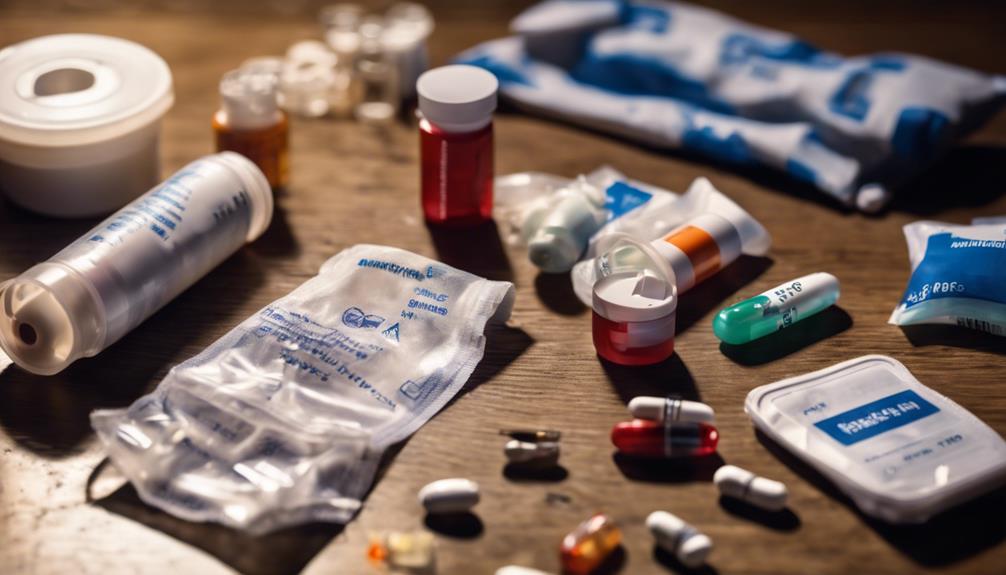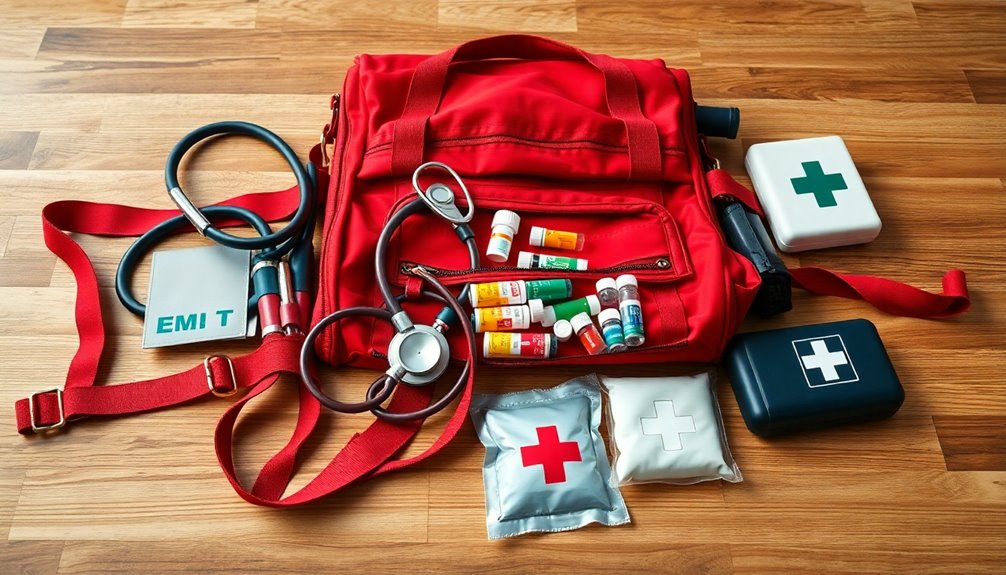When an emergency hits, you need a solid bug-out plan to guarantee quick and effective evacuation. Start by identifying potential threats, then create a clear action plan based on different scenarios. Make certain you pack a bug-out bag with essentials like water, non-perishable food, shelter items, and first aid supplies. Don't forget the Five Ps: account for your family, include pets, gather important documents, and organize medical needs. Choose a reliable bug-out vehicle and map out multiple evacuation routes. Consider safe locations that provide resources. There's more to learn about each step to guarantee your safety in any crisis.
Key Takeaways
- Identify potential threats and develop emergency scenarios to create a clear action plan for evacuation.
- Prepare bug-out bags with essential items like water, food, first aid supplies, and protective gear for each family member.
- Verify all family members, including pets, are accounted for and gather necessary medications and important documents before leaving.
- Choose reliable transportation and map out multiple evacuation routes to ensure quick access to safety.
- Select a bug-out location that is safe, accessible, and equipped with natural resources, avoiding densely populated areas.
Pre-Planning and Preparation

When it comes to quick evacuation, pre-planning and preparation are crucial steps you can't afford to overlook. Start by identifying the potential threats specific to your area. Natural disasters like earthquakes, hurricanes, or wildfires can strike at any moment, but don't forget about man-made threats such as civil unrest or industrial accidents. Assess the likelihood and impact of each threat to guide your planning.
Once you've identified these threats, develop scenarios for emergencies that could happen. This way, you'll have a clear action plan in place. Research historical data and local risk assessments to inform your decisions.
Next, designate safe locations and routes. Choose bug-out spots that are far enough away from immediate danger but still accessible. Make sure these locations have essential resources like water and food. Plan multiple evacuation routes and identify potential hazards along the way. Additionally, ensure that your plan includes designated safe locations that are well-researched and equipped with essential resources like water and food. In addition to designated safe locations and routes, it is essential to establish safe evacuation points in case one route becomes blocked or compromised. These safe evacuation points should also be equipped with essential resources and have multiple access routes to ensure safety and accessibility. By including these safe evacuation points in your plan, you can ensure that you have options and contingencies in place in case of emergency.
Essential Items for Bug-Out Bags

A well-stocked bug-out bag can be your lifeline during an emergency, so choosing essential items wisely is vital. Start with water; pack at least 3 liters per person for three days, along with a collapsible and a hard or metal water bottle. Don't forget water purification systems like Sawyer filters and purification tablets to guarantee safe drinking water.
Next, include non-perishable food items such as energy bars and canned goods. A camp stove, like the MSR PocketRocket 2, and a steel pot or mess kit will help you prepare meals if needed. Consider adding fishing tackle or hunting gear for additional food sources.
For shelter and environmental protection, pack a tent or survival bivy, a waterproof tarp, and clothing for various weather conditions. A poncho can protect you from rain, while sleeping gear like blankets and pillows guarantees comfort. Clothing serves as the primary defense against harsh elements, so choose durable materials suited for your environment.
Lastly, prioritize first aid and hygiene. Your kit should include basic medical supplies, personal hygiene items, and toiletries. N95 masks and nitrile gloves offer extra protection. With these essentials, you'll be better prepared for a quick evacuation.
The Five Ps of Evacuation

Packing a bug-out bag is just the start of preparing for an emergency evacuation. The Five Ps of Evacuation—People, Pets, Prescriptions, Papers, and Photos—are essential for a successful and organized departure.
First, verify all family members are accounted for and ready to go. Think about the unique needs of infants, children, and elderly relatives. Don't forget to notify out-of-town contacts about your plans. Emphasizing community education and awareness can further enhance your family's readiness for any emergency.
Next, include pets in your evacuation strategy. Pack their supplies, such as food, water, and medications, and confirm they have proper identification and health records. Plan for their safe transportation.
When it comes to prescriptions, gather essential medications and medical equipment. Include any vision or hearing aids, along with their batteries. Make certain everything is easily accessible.
Organize important papers like insurance documents and identification. Create both hard and digital copies for safety. Storing these in a secure location will save you time and stress.
Lastly, don't overlook cherished photos and mementos. Digitizing them can provide extra security. By addressing each of the Five Ps, you'll pave the way for a smooth evacuation.
Transportation and Routes

In an emergency, having reliable transportation and clear routes is essential for a successful evacuation. You need to choose a bug-out vehicle that suits your needs and the terrain you'll encounter. Consider options like SUVs for their storage and off-road capability, trucks for family transport, or even bicycles for urban maneuverability. A reliable bug-out vehicle will ensure you can navigate through challenging environments effectively.
Here's a quick comparison to help you decide:
| Vehicle Type | Key Features |
|---|---|
| SUVs | Large storage, customizable, off-road |
| Motorcycles | Agile, good for traffic, limited cargo |
| Bicycles | Human-powered, trailer-equipped |
Regardless of your choice, make certain your vehicle is prepared. Equip it with a bug-out bag, an emergency kit, food, and water supplies. Check for fuel efficiency and reliability—these factors can make all the difference when you're on the move. Don't forget to map out clear evacuation routes ahead of time. Familiarize yourself with alternative paths and avoid congested areas, so you can get to safety quickly and efficiently.
Bug-Out Location and Shelter

Choosing the right bug-out location is just as important as having reliable transportation. You need a site that's far enough from immediate dangers but close enough to reach in a crisis—ideally within a few hours by car or a few days on foot. Consider multiple transportation options, including vehicles, bicycles, or hiking, to adapt to your situation.
Avoid high-density population areas to reduce risks like social unrest and resource shortages. Remote locations offer a safer environment, helping you steer clear of potential conflicts and health risks. Prioritize properties with natural water sources, like springs or rivers, and guarantee you have legal access to these resources. Don't forget about water purification methods and rainwater collection systems for additional safety. Access to clean water is imperative for survival, so make sure your chosen location has reliable sources.
When selecting your shelter, look for areas with natural concealment and defensibility. Make sure the land can be easily secured and complies with local building codes. Finally, consider the infrastructure—adequate storage for supplies and protection against extreme weather are essential. A well-chosen bug-out location combined with a solid shelter plan can make all the difference in an emergency.
Frequently Asked Questions
How Can I Create a Bug-Out Plan for My Specific Needs?
To create a bug-out plan tailored to your needs, start by identifying potential disasters in your area. Research past events to understand risks. Next, set clear stay/go criteria for each disaster type. Choose safe bug-out sites and map out multiple routes to avoid congestion. Assemble a bug-out bag with essentials, and coordinate with family or friends for support. Regularly practice your plan to guarantee everyone knows what to do when it's time to leave.
What Are the Best Ways to Stay Informed During an Evacuation?
Staying informed during an evacuation is essential, and it's a myth that you can rely solely on social media for updates. Instead, tune in to local TV or radio stations for official alerts. Sign up for emergency notification systems and keep an eye on government websites for real-time information. Familiarize yourself with evacuation maps and stay connected with family and friends through a communication plan. Being proactive can make all the difference in an emergency.
How Often Should I Update My Bug-Out Bag Supplies?
You should update your bug-out bag supplies at least twice a year. Regular seasonal adjustments guarantee you've got the right clothing and gear for changing weather conditions. Keep food fresh by replacing items before they expire, and make certain to check your tools for any damage. If your personal or family circumstances change, like health issues or new family members, revise your bag accordingly to meet everyone's needs.
What Should I Do if I Get Separated From My Family?
If you get separated from your family during an emergency, stay calm and remember your pre-defined meeting point. Use your communication devices to check in with them or utilize backup methods like two-way radios. If you can't reach them, head to the designated safe zone. Keep an eye out for recognizable clothing or items they might be carrying. If necessary, inform local authorities about your situation to aid in reuniting.
How Can I Prepare My Pets for Evacuation?
Imagine your pet as a tiny lighthouse in a storm, guiding you home. To prepare for evacuation, pack a few days' worth of food and water in waterproof containers. Include their medications and a first aid kit for emergencies. Secure them in a sturdy crate for transport and keep their ID tags updated. Identify pet-friendly shelters and have an emergency contact list ready. This way, you guarantee your furry friend's safety amidst chaos.
Conclusion
When the storm brews and chaos reigns, you'll be ready to dance through the chaos. By planning ahead, packing smart, and knowing your routes, you turn uncertainty into a well-choreographed escape. Your bug-out bag is your trusty companion, and your chosen shelter is your refuge in the storm. So, embrace the winds of change with confidence, knowing you've got the essentials to weather any crisis. Stay sharp, stay prepared, and let adventure lead the way!










